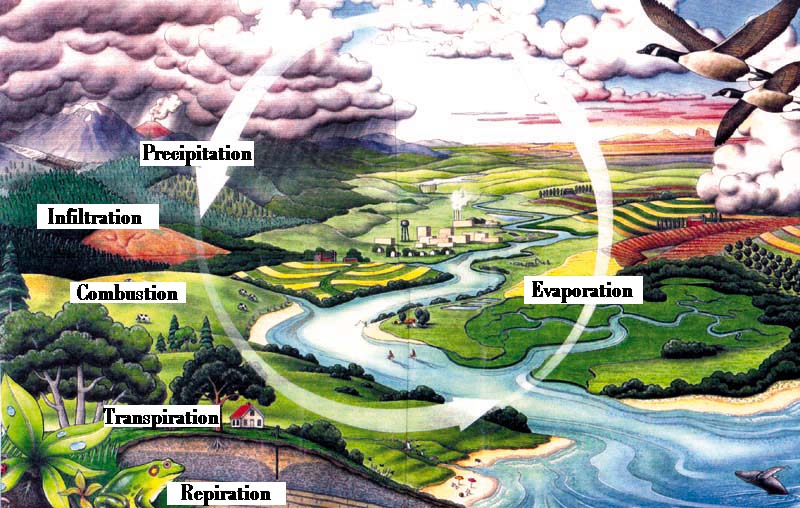Lesson Plan - Water Cycle
Component
The student recognizes that processes in the atmosphere interact to
shape the Earth
The student uses technology tools to enhance learning, increase productivity,
and promote creativity

Objectives
- Discuss the water cycle and how air temperature and moisture influence
it.
- Vocabulary: introduce water cycle terms: evaporation, transpiration,
precipitation, collection, condensation
and water vapor. Have students watch this video and answer: Explain how rain or
precipitation starts. The
Water Cycle
- Have students draw water cycle sequence:
- The Sun
heats water in lakes and oceans, causing it to evaporate and become water
vapor, a gas.
- Water vapor rises, cools and condenses to form tiny water
droplets or ice crystals in clouds.
- When the droplets or crystals grow
heavy enough, they fall back to Earth as precipitation.
- Most water returns
to the sea or sinks into underground water source
- The Sun heats it up;
the cycle starts again.
- Conduct Is There Water in the Air?
Experiment
- Use Checklist for Science for evaluation
- Read about
the Water Cycle at Earth
Floor (click on Cycles, then click on Water Cycle) answer "Does all rain and snow that forms fall to the ground?"
- Answer: No, it may evaporate in the air before reaching the ground
- Ask Earl: "How do you make water disappear?" Yahooligans
Ask Earl
- Answer: After a large downpour, a rain puddle will eventually evaporate
because the heat from the sun energizes the water molecules to break free
from each other. So the water turns from a liquid into a gas. Clouds are
just floating clumps of this water vapor. When this water vapor cools
rapidly, it will turn back to liquid, in the form of rain!
Is There Water in the Air?
*Materials
4 8-oz. plastic cups, ice water, refrigerator, freezer (ice chest can
be substituted)
*Introduction
Fill one of the cups with ice water and set on table and feel the outside
of the cup (It will feel moist. Water vapor in the air condenses against
the cold outside of the cup.)
*Problem statement
Is There Water in the Air?
*Purpose
To determine if there is water in the air
*Hypothesis- I think...
- Moisture forming on the outside of the cup is coming from the air
- Moisture forming on the outside of the cup is coming from the cup
*Procedure
- Place one empty cup on table as control
- Place second cup in refrigerator
and third in freezer
- Wait ten minutes
- Remove cups from refrigerator
and freezer and observe
*Results
Some water vapor will condense against the cold inside and outside
of the cups.
*Conclusion
(in student's own words)
Competency
After participating in hands-on group investigations, student will
determine that air contains water (water vapor) and it is effected by air
temperature.
What percentage of the earth's water is fresh? Find out at
Mobot. Click on Water Cycle
Answer: 3% of the earth's water is fresh
Homework
Listen to daily weather forecast or log onto weather web site and determine
the air temperature and humidity for the day.
Guest Speaker
Invite a meteorologist to the class to talk about the water cycle and its
effect on climate.
Resource
Weiner. J. Planet Earth. Bantam Books. New York. 1986.


